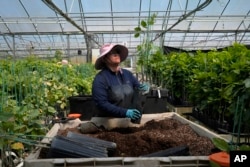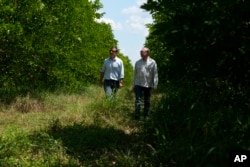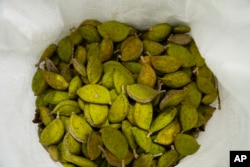American farmers are using an ancient tree from India to produce beans for making protein-rich foods and biofuels.
The tree is called pongamia. It is native to India, Southeast Asia and Australia. But farmers in the southern state of Florida have found the tree grows well there too.
In some parts of Florida, pongamia trees have now replaced citrus trees, which have long faced major struggles with disease.
Pongamia trees produce a small brown bean known as a legume. The legume can be used in the production of several products, including cooking oil and protein-rich foods. The beans can also be used to produce a biofuel, mostly for airplanes.
Pongamia do well in Florida because the trees like hot temperatures and can survive in dry or rainy conditions. They also do not require special additives, called fertilizers, or chemicals to kill insects and other life that might threaten growth.
And unlike fruits like oranges and grapefruit, the beans do not require teams of workers to pick. Instead, they can be easily collected with a machine that shakes the trees and makes the legumes fall to the ground.
A San Francisco-based company, called Terviva, has invented a process that removes substances from the bean that gives it a bad taste so it can be used for food production.
The company’s founder, Naveen Sikka, told The Associated Press that Terviva has been able to offer Florida farmers a new chance to replace their failed citrus crops. Pongamia, he said, “is the perfect fit” to help them rebuild their businesses.
Ron Edwards is the chairman of Terviva's board of directors. He is also a long-time Florida citrus grower. He told the AP that turning this wild tree into an agricultural success story was not easy. “There are no books to read on it, either, because no one else has ever done it,” Edwards said.
In addition, he said bees and other pollinators that feed on the tree’s flowers help support the local environment.
Edwards added that an estimated one half hectare of the trees could provide the same amount of oil as about 1.6 hectares of soy beans. The pongamia bean also produces a high-quality protein that can be used to make many plant-based products. “There’s a lot of potential for the food industry and the oil and petroleum industry,” Edwards said.
Experts say the problems linked to Florida’s citrus crops – disease and climate issues – have also affected most of the world’s top citrus-producing nations.
For example, this year's harvest in Brazil – the world’s largest exporter of orange juice – is expected to be the worst in 36 years. The Brazilian citrus group Fundecitrus made that prediction after a period of major flooding and then extended dryness.
But Edwards noted that climate and disease have little effect on pongamia trees. “It’s just tough, a jungle-tested tree” he said. “It stands up to a lot of abuse with very little caretaking."
Pongamia also grows well in Hawaii, where it is now being used on land where sugarcane once grew.
John Olson is a Florida farmer who replaced his grapefruit trees with 87 hectares of pongamia. He told the AP he felt he had little choice because, “For the most part, the citrus industry has died in Florida.” Olson said his grapefruit business was a profitable operation throughout the 1980s and 1990s, although the farm was not large.
Edwards said he is happy that pongamia trees have replaced some citrus trees in Florida. And he said he likes that pongamia oil can replace some oils that are more environmentally damaging to produce.
I’m Bryan Lynn.
The Associated Press reported this story. Bryan Lynn adapted the report for VOA Learning English.
___________________________________________
Words in This Story
citrus - n. a kind of fruit that includes oranges, lemons, grapefruits, etc.
pollinate – v. to carry pollen from a male part of a flower to the female part of another flower of the same kind
petroleum – n. a dark, thick oil that comes from the ground and is used to produce gasoline and other products
tough – adj. able to take great force
jungle – n. an impenetrable thicket or tangled mass of tropical vegetation













Forum